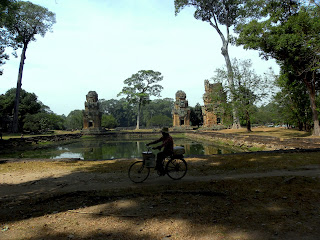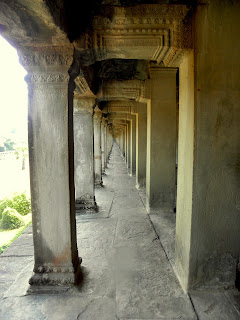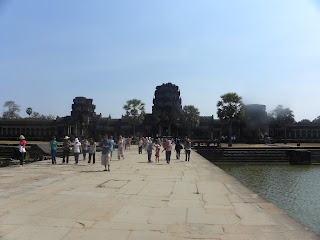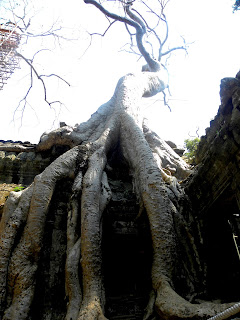Our arrival in Cambodia was the one part of the trip I researched obsessively. I was determined not to get scammed. After two almost scams, I made it safely to Siem Reap from Poipet, but it was fairly stressful.
I basically wanted to go to Cambodia to see Angkor Wat. Sophie brought a book she found in her room about the temples, with suggested tours and information about each crumbling rock and wall carving. I learned a lot about religions (Buddhism and Hinduism) and Cambodian history, but I think the best way to present Angkor Wat to my admiring fans is through the art of photography. I'll try to not write too much...
Day 1: Angkor Thom (Bayon, Bauphon, Phinieanakas, Terrace of the Leper King and Terrace of the Elephants)
Angkor Wat is the biggest, and best preserved temple. However, there are so many other temples in the area that draw just as many tourists and deserve just as much fame. So when people say they're going to Cambodia to see "Angkor Wat," they actually mean that they are going to Angkor Wat and all the other surrounding temples. "Angkor Wat" actually means "city of temples" so remember, it's both a specific temple and a cluster of temples. It would take a few weeks to see them all, but I'm happy with what I saw on my three-day pass.
Quick overview: The temples in Angkor Wat were built over many centuries, by different kings who followed different religions. In general, most kings added onto the temples and/or built their own. Many of the temples were once used for Hindu prayer, but when the country became Buddhist, the sculptures and reliefs were edited to reflect Buddhist tenets.
On the way to Angkor Wat with our tuktuk driver, who, interestingly, is also 23 years old.
The entrance to Angkor Thom
The walkway to Angkor Thom
Consorts of the Leper King. He may be a leper, but he still gets all the ladies
Beautiful writing
Bauphon, a temple dedicated to Shiva but then rededicated to Buddha
Bauphon
View from Bauphon
In Bauphon
Monks making a pilgrimage to Angkor Wat
Terrace of the elephants
Bayon, a Buddhist shrine
Bayon is known for having around 50 huge stone faces on its many, many towers that look toward north, east, south, and west
Bayon is also known for its bas-reliefs
Devatas, Hindu deities
I love that crazy elephant

Some soldiers, doing as soldiers do.
A close up of the picture above... the detailing on each relief was incredible at all the temples. The shirts have patterns
Day 2: Banteay Srei
Banteay Srei is a temple an hour away from Angkor Wat dedicated to Shiva. It's especially famous for its incredibly fine and miniature carvings. Some scholars believe that women decorated this temple, because the buildings and the artwork are extremely small.
Entering Banteay Srei
The towers
A good example of the red sandstone used to build the towers and the incredibly detailed decorations
A view of the whole temple complex
Banteay Srei isn't so big, and Sophie was intent on finding this specific pediment. It tells the story of Siva and his wife Uma. According to legend, Kama (tiny and on the right top) fired an arrow at Siva (center) to fall in love with Uma (left.) It took us a surprisingly long time, but it was so rewarding when we finally found it!
Day 3: Angkor Wat and Ta Prahm
First... pictures from Angkor Wat at sunset (day 1)
I was supposed to go with Sophie to see Angkor Wat at sunrise on day 3, but I had a little too much fun at "Angkor What?", a popular Siem Reap bar, and was too tired to do the 4 AM wake up call. I saw the sunset, I saw the pictures of sunrise, I was really sad but I've made my peace.
Later that morning, we went to Angkor Wat. It's a huge complex, and the most famous bas-reliefs are on all four sides of the main area in long hallways (my favorite one was "The Churning of the Sea of Milk," the story of creation.) Inside, there are towers and large areas, I can't really describe it. Honestly, this was my least favorite of all the temples because it was so crowded, and it's mostly bas-reliefs. It just didn't have the same character as the other temples. But let's be real, it was still pretty awesome.
A looooooong hallway
He is riding a water buffalo and it's important.
A view off of an Angkor Wat tower
Performers at the temple
Cute couple taking wedding pictures
Next, we hit up Ta Prohm. Ta Prohm was actually my favorite temple, but Banteay Srei and Bayon were close seconds. In a stroke of sheer genius, the explorers who discovered Angkor Wat decided to leave one temple "as they found it," still in ruins with no restoration. Of course, they restored it so that it is not dangerous for tourists. However, the carvings aren't perfected with different colored stones, and there is still lots of rubble and rocks around every corner. I think what I loved about it was the moss (such a great color) and the seriously amazing trees that grew into the temple. They are destructive trees that are slowly destroying the temple, but they're so completely cool that I didn't care.
Look at that TREE! What?!?
Rubble rubble, your face is a mess.
Me, and my temple pants
When trees attack
Apparently this is a famous shot from "Laura Croft: Tomb Raider." So I'm told.
A rare photo of the two of us, together!
In a word, Angkor Wat was incredible. Memorable. Unforgettable. Edible. Kidding. But speaking of food...
Since Cambodia is not known for food the way Thailand is, it was easy to find the few restaurants recommended by Lonely Planet. Hands down, the best one was "Khmer Kitchen" on Alley Street. Lonely Planet recommended Mick Jagger's favorite dish from the establishment: coconut and pumpkin soup. It was amazing... definitely one of the best dishes I had on my entire trip. Lonely Planet also recommended a Western restaurant, and since we rarely ever eat Western food (ever) we went there and I got to eat feta cheese, which is newsworthy for me but probably not for anyone else. I also tried some more traditional Siem Reap foods, like "fish amok" and fresh spring rolls.
Sidenote: apparently Siem Reap has a similar amount of transvestites and transgender people living in large cities as Thailand, and some "lady boys" as they are called in Southeast Asia came and sat with Sophie and me during our first dinner in Siem Reap. Just sharing.
I like posing with food. OK?
Traditional Cambodian sample platter: "fish amok," spring rolls, ribs, mango salad, and other delicious foods all served on banana leaves.
We only stayed in Cambodia for three days, which is not really enough time to see Angkor Wat let alone explore the country. We thought about staying in Cambodia instead of going back to Thailand for the last two days of our trip, however, we decided against it for a few reasons. Basically, Siem Reap was an emotionally taxing city for me, personally, to visit. I felt like people were constantly trying to take advantage of me. For instance, a very recent Lonely Planet guide insists that a tuktuk driver for the day should cost about $10 (the best way to see Angkor Wat is to hire a "tuktuk," a small motorized taxi, for the day.) My hostel wanted to charge $15-$18 for a tuktuk driver, to which I said, "Thank you, but it's too expensive for me." The lady blew up angrily at me, yelling that the cost of gas is expensive (I saw my tuktuk driver pay for gas once, it was under $0.50) and that the tuktuk driver needs to be paid enough. I hadn't even tried to bargain, I was just asking so I could compare prices later. And the worst part is, she's right. $5 is not that much for an American, so I felt guilty insinuating that I should pay less. I felt ridiculous bargaining at the night market over 50 cents, but that's just how Cambodia works! (Side note: Cambodia uses American bills, but doesn't use American coins. The Cambodian "riel" is used as change. $1 is about 4,000 riel: so if something is $0.50 and you paid with a dollar, you would get 2,000 riel back.) Basically, I didn't want to be the "dumb" tourist who paid more for something when I could have bargained down, but arguing over $1 felt petty, even though $1 can buy you a lot in Cambodia. It was such a terrible feeling. This story is amplified by a million on my trip from Poipet (at the border of Thailand and Cambodia) to Siem Reap... that was unpleasant and something I don't wish to do again anytime soon.
My traveling is limited to fairly well-off countries, so I have never really experienced being a tourist in a place where the tuktuk drivers, masseuses, waiters, and people at the market are relentless in trying to get tourists to buy their products. Of course, I've experienced that kind of harassment before, like at the Eiffel Tower or Leaning Tower of Pisa. However, I've never been to a place where it is on the scale of Cambodia before. And the begging was heartbreaking, especially the children. I passed by two schools on my way to Banteay Srei, and they were both empty. I passed by shack-like homes that had naked children playing with deflated truck tires and sticks. I've never been to a place like Cambodia before. I got the impression that kids often don't go to school, or if they do, they spend their mornings selling wares to tourists and their afternoons at school. The way they advertised, saying "postcards, postcards, $1" or "I don't want money, I just want food," almost became like a song. They said it so often, with so few successful results, that they looked bored but at the same time desperate and tired. One girl actually pinched my ribs, hard, when I didn't give her money.
Children playing with monkeys
A market
A child at work
Children playing in the water
Markets
Seeing the impoverished children and the houses in Cambodia made me think a lot about what I could do to help. I think after I live in China I will not want to continue teaching abroad, but my grandma did the Peace Corps in her sixties, so who knows, perhaps I will get the chance to work in Cambodia. However, how much help I can actually give in a country like Cambodia? Volunteer to teach English? Work in an orphanage? Build homes for people? Adopt a Cambodian child? All of those things are helpful by my (Western world) standards but maybe that's not actually helpful in the long run. I think about the same things teaching in China: what is it about teaching English that's such a great gift to my students? I know that English has become a "universal language" in a lot of ways, but I am not so sure that teaching kids "Baby" by Justin Bieber is really the most helpful thing I could do for them. Learning is learning, and I (with my Western world ideas) think that education is always a good thing, and the Chinese pretty much agree, but it's so different in Cambodia.
Basically, Cambodia made me feel a lot of emotions. What I really wanted was to see the non-touristy side of Cambodia, but thinking realistically, as a female traveller with no knowledge of the language or culture, that would have been impossible. It would have been great if I had a friend living in a remote village in Cambodia: then I could have seen what I wanted. So I think in the end, going back to Thailand was the right move. But who knows, maybe I will get a chance to go back!





























































No comments:
Post a Comment